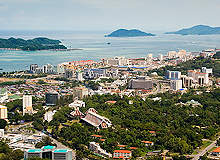
The Sabah Oil and Gas Terminal (SOGT) is a part of the Sabah-Sarawak Integrated Oil and Gas Project (SSIOGP) undertaken by Petronas Carigali in the state of Sabah, in east Malaysia. The terminal processes oil and gas produced from the region’s offshore fields.
The integrated project involved construction of an upstream infrastructure to tap offshore oil and gas reserves in the Sabah region and process the produced resources. It included offshore field development, construction of the SOGT and a 512km onshore pipeline called the Sabah-Sarawak Gas Pipeline.
The new terminal is needed because crude oil terminal Labuan and natural gas terminal KG Gayang do not have sufficient capacity to handle oil and gas production from new fields.
The Sabah terminal became operational in December 2013. It is designed to handle 300,000 barrels of oil a day and 1.25 billion cubic feet (bcf) of gas a day. Sabah’s capacity is equivalent to about 40% of Malaysia’s crude oil production.
The SOGT serves the offshore fields developed as part of the Sabah-Sarawak Integrated Oil and Gas Project. The fields include Gumusut / Kakap, Kinabalu Deep and East, Kebabangan and Malikai.
Sabah site
The Sabah terminal occupies a 250-acre greenfield site at Kimanis, a township that lies 45km from the city of Kota Kinabalu. The location is proximate to a number of Sabah offshore fields.
The nearby port at Bintulu may be used to export oil and condensate cargo from the terminal.
Contracts
Samsung Engineering was awarded the engineering, procurement, construction and commissioning (EPCC) contract. The MYR2.44bn ($770m) contract was signed in October 2010.
Samsung Engineering partnered with Malaysian construction company Naim Cendera (NCSB Engineering) to execute the project. Naim was responsible for the construction of support infrastructure such as roads, bridges, earthworks and site offices.
RNZ Integrated, a division of the RNZ Group, was involved in the design and engineering of the terminal between October 2006 and February 2009. KASI (Malaysia) conducted a comprehensive review of the design.
The Sabah-Sarawak pipeline construction contract was awarded to a consortium of Punj Lloyd, Dialog E&C and Petrosab Logistik in 2008. The consortium was led by Punj Lloyd.
Chemsain Konsultant carried out the environmental impact assessment and quantitative risk analysis (QRA) for the integrated project.
Construction of Sabah terminal
The proposal to build a new oil and gas terminal at Sabah was put forward in 2005.
Ground-breaking was held in February 2007 by the then Prime Minister of Malaysia, Dato’ Seri Abdullah Haji Ahmad Badawi.
The Samsung-Naim joint venture achieved mechanical completion of the terminal by late 2013.
Infrastructure
The terminal is equipped with infrastructure to receive, process, store, measure and export crude oil and gas / condensate.
Subsea pipelines were laid to connect the terminal with the offshore fields of the integrated project.
Processing at Sabah
The crude oil and gas / condensate reaching the Sabah terminal is separated and stored in tanks. The gas is sent to the Petronas LNG Complex in Bintulu via the Sabah-Sarawak pipeline, for processing and further export or sale.
The LNG complex has eight production trains with a total processing capacity of nearly 23 million tonnes of hydrocarbons a year.
The oil and condensate is exported through moorings.
Pipeline route
The onshore pipeline is 90km-long in Sabah and 422km-long in Sarawak. It begins in Kimanis and ends at Bintulu.


